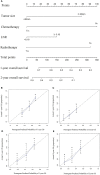Development and external validation of a dynamic nomogram to predict the survival for adenosquamous carcinoma of the pancreas
- PMID: 36033500
- PMCID: PMC9411813
- DOI: 10.3389/fonc.2022.927107
Development and external validation of a dynamic nomogram to predict the survival for adenosquamous carcinoma of the pancreas
Abstract
Objective: We aimed to develop a nomogram to predict the survival and prognosis of adenosquamous carcinoma of the pancreas (ASCP).
Background: Adenosquamous carcinoma of the pancreas (ASCP) is a relatively rare histological subtype of pancreatic exocrine neoplasms. It was reported a worse survival in ASCP than in pancreatic adenocarcinoma (PDAC). Prediction of ASCP prognosis is of great importance.
Methods: Histologically confirmed ASCP patients from the National Cancer Institute's Surveillance, Epidemiology, and End Results (SEER) Program database were finally enrolled and divided into development and internal validation cohorts. Moreover, a multi-center cohort of 70 patients from China was registered as the external validation. A nomogram was developed based on independent predictors of ASCP determined in multivariable analysis.
Results: A total of 233 patients from SEER were finally included. Univariate and Multivariate analysis showed that tumor size, radiotherapy, chemotherapy, and lymph node ratio (LNR) were considered the independent prognostic indicators. We developed a nomogram according to these four parameters. The C index of the nomogram in the development cohort was 0.696. Through analysis of the area under the curve (AUC) of the different cohorts, we observed that the predictive efficacy of the nomogram for 1-, and 2-year overall survival (OS) were better than those of the American Joint Committee on Cancer (AJCC) TNM (8th) staging system both in the development and validation cohort. External validation confirmed that 1-year survival is 67.2% vs. 29.7%, similar to the internal cohort analysis.
Conclusion: The nomogram showed good performance in predicting the survival of ASCP. It could help surgeons to make clinical decisions and develop further plans.
Keywords: adenosquamous carcinoma; nomogram; pancreas; prognosis; the TNM 8th staging system.
Copyright © 2022 Ren, Ma, Jin, Ding, Jiang, Wu, Li, Yang, Han, Ma, Wu, Shi and Wang.
Conflict of interest statement
The authors declare that the research was conducted in the absence of any commercial or financial relationships that could be construed as a potential conflict of interest.
Figures



Similar articles
-
Comparison of prognostic prediction between nomogram based on lymph node ratio and AJCC 8th staging system for patients with resected pancreatic head carcinoma: a SEER analysis.Cancer Manag Res. 2018 Feb 5;10:227-238. doi: 10.2147/CMAR.S157940. eCollection 2018. Cancer Manag Res. 2018. PMID: 29440932 Free PMC article.
-
Establishment of a nomogram model for predicting distant metastasis in pancreatic ductal adenocarcinoma: a comparative analysis of different lymph node staging systems based on the SEER database.Sci Rep. 2024 Aug 5;14(1):18136. doi: 10.1038/s41598-024-69126-8. Sci Rep. 2024. PMID: 39103506 Free PMC article.
-
Survival Analysis and Prediction Model of ASCP Based on SEER Database.Front Oncol. 2022 Jun 24;12:909257. doi: 10.3389/fonc.2022.909257. eCollection 2022. Front Oncol. 2022. PMID: 35814413 Free PMC article.
-
Development and validation of prognostic model based on extragastric lymph nodes metastasis and lymph node ratio in node-positive gastric cancer: a retrospective cohort study based on a multicenter database.Int J Surg. 2023 Apr 1;109(4):794-804. doi: 10.1097/JS9.0000000000000308. Int J Surg. 2023. PMID: 36999785 Free PMC article.
-
Dynamic nomograms combining N classification with ratio-based nodal classifications to predict long-term survival for patients with lung adenocarcinoma after surgery: a SEER population-based study.BMC Cancer. 2021 Aug 4;21(1):653. doi: 10.1186/s12885-021-08410-6. BMC Cancer. 2021. PMID: 34344326 Free PMC article.
Cited by
-
Development and validation of a predictive model for febrile seizures.Sci Rep. 2023 Oct 31;13(1):18779. doi: 10.1038/s41598-023-45911-9. Sci Rep. 2023. PMID: 37907555 Free PMC article.
-
A deep learning-based model (DeepMPM) to help predict survival in patients with malignant pleural mesothelioma.Transl Cancer Res. 2023 Oct 31;12(10):2887-2897. doi: 10.21037/tcr-23-422. Epub 2023 Sep 22. Transl Cancer Res. 2023. PMID: 37969363 Free PMC article.
-
Genetic characteristics and clinical-specific survival prediction in elderly patients with gallbladder cancer: a genetic and population-based study.Front Endocrinol (Lausanne). 2023 Apr 21;14:1159235. doi: 10.3389/fendo.2023.1159235. eCollection 2023. Front Endocrinol (Lausanne). 2023. PMID: 37152947 Free PMC article. Clinical Trial.
-
Metastatic pattern and prognosis in patients with lung adenosquamous carcinoma: A surveillance, epidemiology, and end results-based population study.Heliyon. 2024 May 6;10(9):e30641. doi: 10.1016/j.heliyon.2024.e30641. eCollection 2024 May 15. Heliyon. 2024. PMID: 38765098 Free PMC article.
-
Development and validation of a nomogram for predicting overall survival in patients with sinonasal mucosal melanoma.BMC Cancer. 2024 Feb 7;24(1):184. doi: 10.1186/s12885-024-11888-5. BMC Cancer. 2024. PMID: 38326751 Free PMC article.
References
LinkOut - more resources
Full Text Sources

